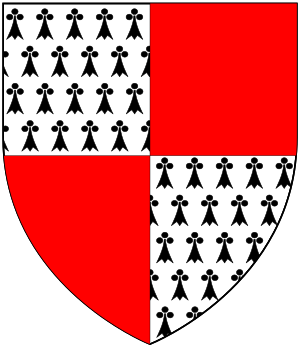John Stanhope, 1st Baron Stanhope facts for kids
John Stanhope, 1st Baron Stanhope (born around 1549 – died 9 March 1621) was an important English courtier, politician, and noble during the time of Queen Elizabeth I and King James I. He held many key positions and was a trusted helper to the Queen.
Contents
John Stanhope's Life
John Stanhope was the third son of Sir Michael Stanhope. He was born in Yorkshire but grew up in Nottinghamshire. His father faced serious legal trouble in 1552, but this did not stop John's own career.
Early Career and Royal Service
John Stanhope likely served as a Member of Parliament (MP), which means he was a representative in the country's law-making body. He represented different areas like Marlborough, Truro, and Rochester in the late 1500s.
At the royal court, he was a Gentleman of the Queen's Privy Chamber. This meant he was a close assistant to Queen Elizabeth I. In 1589, he wrote a letter describing the Queen's good health. He mentioned she would often dance six or seven galliards (a lively dance) in the morning, along with music and singing.
Important Roles and Challenges
Over time, Stanhope became a strong supporter of Sir Robert Cecil, a very powerful figure at court. Because of this friendship, Stanhope received many important jobs. For many years, he was in charge of local records and naval affairs in the North Riding of Yorkshire. He was also part of the Council of the North, which helped govern that region.
In 1590, he was put in charge of the country's mail system as the Master of the King's Posts. In 1596, he was made a knight, becoming "Sir John Stanhope." He was also appointed Treasurer of the Chamber, meaning he managed the Queen's household money.
In 1597, Stanhope tried to become an MP for Yorkshire. He thought he would win easily because of his background and Cecil's support. However, the people of Yorkshire preferred a local candidate, Sir John Savile. Even though Savile had fewer well-known supporters, he was popular with many local workers. Stanhope lost in a very challenging election. Even after the authorities tried to intervene, they could not change the election result.
Becoming a Baron
After losing in Yorkshire, Stanhope quickly found another seat in Parliament for Preston. This area was under Cecil's influence. He later represented Northamptonshire in 1601 and Newtown from 1604.
On 2 May 1605, he was given a special title and became a Lord. He was known as Baron Stanhope, of Harrington. This was a great honor.
Later Years and Legacy
As a key follower of Sir Robert Cecil, it was even rumored that Stanhope might become the Lord Chancellor, a very high legal position. Instead, he was appointed Vice-Chamberlain of the Household, another important role in the royal household.
In 1603, he was part of a group called "Commissioners to treat of a Union between England and Scotland." Their job was to help arrange for the King of Scotland, James VI, to also become King of England. In 1609, he joined the council of the Virginia Company, which was involved in setting up colonies in America.
John Stanhope retired from his roles in 1616 and passed away in 1621. His son, Charles Stanhope, took over his title and his role as Master of the King's Posts.
His Family
John Stanhope was married twice. His first wife was Joan Knollys, but they did not have any children. His second marriage was on 6 May 1589, to Margaret Macwilliam. She was the daughter of Henry Macwilliam, who was one of the Queen's gentlemen.
With Margaret, he had three children:
- Charles: Born in 1593, he became the second Baron Stanhope. He died in 1675 without children, and so the title ended.
- Elizabeth: She married Sir Lionel Tollemache, 2nd Baronet.
- Catherine: She married Robert, Viscount Cholmondeley.
Margaret died in 1640 and was buried next to her husband. Later members of the Stanhope family who became nobles came from John's brother, Thomas.


